Tapioca pearls, or boba, are translucent and sweet pops of goodness that give drinks and desserts an extra chewy bite. While I love asking, “Boba?” after every meal, I also like to cook these at home since it’s pretty easy and worth it if you’re making drinks for a group of people.
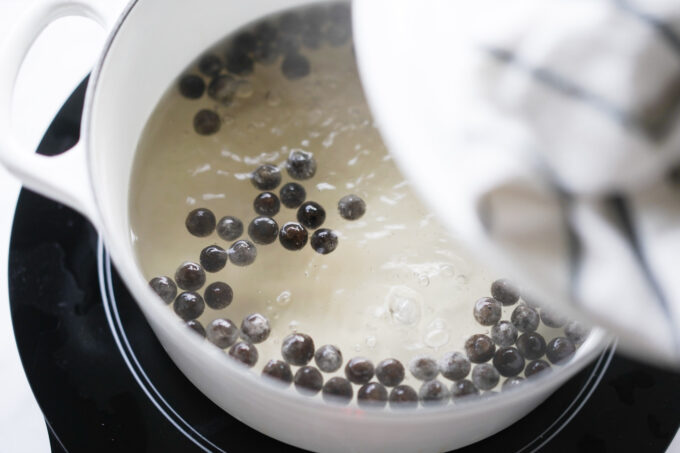
Where to start
If you have white boba, I have a separate post about how to cook white tapioca pearls. While it is very similar, there are some brand-specific differences which could matter if you happened to buy those.
If your package of tapioca pearls comes with instructions, following that is your best bet since cooking methods and times can vary greatly between brands.
If the silly manufacturers sent you packing with a bag of boba without instructions for some reason, the 30 & 30 method below is a good start, since it worked for most brands of boba I tested, whether it required a slight time reduction, or multiple rounds.
The brands I tested
- Bossen Tapioca Pearls (Large Boba): Use the 30 & 30 method listed below. This boba is what some would call “fresh boba” because you can easily crush them in between your fingers and it has a shorter shelf life than other brands.
- E Fa Brand Boba: Follow the instructions on the package. If you can’t find WuFuYuan boba, I would recommend buying this brand because it’s just as quick to make (really five minutes!) and has easy to follow instructions. This brand also has a long shelf-life after opening.
- Tea Zone Original Tapioca Pearls (Boba): Use the 30 & 30 method. Similar to the Bossen tapioca pearls, this brand also has “fresh boba” that is easily crushable, so you need to be careful when handling. It has a similar texture as regular boba.
- Tea Zone Instant 10 Tapioca Pearls (Boba): Follow the instructions on the package. Of all the boba I tested, this was my least favorite because it didn’t have the right consistency and it was also smaller than the rest of the boba. Even following the package carefully, I ended up with slightly hard boba. Unlike the E-Fa and WuFuYuan quick style boba, it took more than 10 minutes due to the resting period.
- Tea Zone Chewy Tapioca Pearls (Boba): Use the 30 & 30 method. What is really nice about this boba is that it really is very chewy and I prefer this texture to the traditional Tea Zone Original version. I would recommend this if you like your boba extra chewy.
- WuFuYuan Black Boba Tapioca Pearls (5 Mins): Follow the instructions on the package. This boba is my favorite because it’s super quick (it really takes five minutes) and it gives you nice and chewy boba.
If you have a specific brand that I haven’t tested, I would recommend using the 30 & 30 method below as a starting point. If it gets too soft, reduce the cooking time. If its still raw in the center, consider additional rounds of cooking and resting the pearls.
The 30 & 30 cooking method
This means 30 minutes of cooking followed by 30 minutes of rest. If you’ve never made boba at home before, the 30 & 30 method is a great way to start without being too confused especially since many brands have different types of boba. This method also works for many white tapioca pearls too! So far, this method has yet to fail me.
Step 1. In a large pot, boil about ten cups of water for every ½ cup of dried tapioca pearls. For every half a cup of dried boba, it makes about one cup of cooked boba. (Please refrain from rinsing boba before cooking because they may disintegrate)
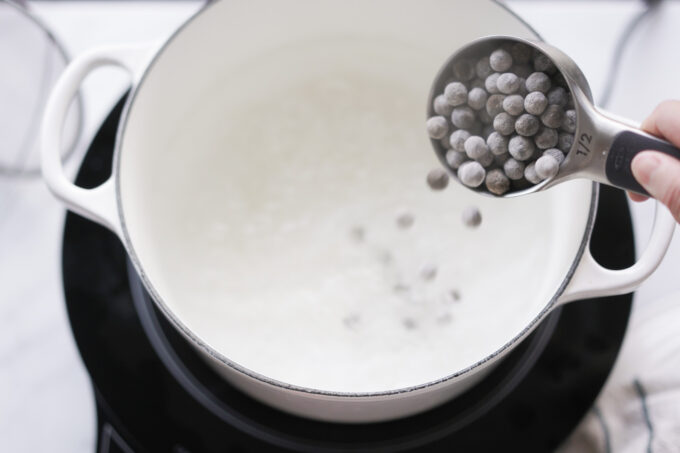
Step 2. Once you have a rolling boil, add your dried tapioca pearls into the pot and wait for the boba to float. This should take about 30 seconds. Once all the boba float to the top, lower the heat to medium and keep a simmer. Continue to cook for 30 minutes uncovered.

Step 3. After 30 minutes, move the pot off the stove, cover it with a lid, and let it rest for an additional 30 minutes. Then, strain the boba and run them under cold water to remove the excess starch around them.
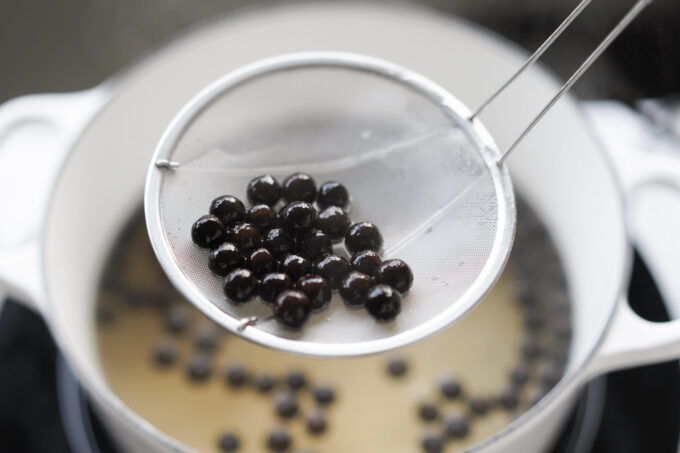
Step 4. Taste test your boba and see if they have a chewy consistency throughout. While this technique typically works the first time around, if you do find the center is still hard, repeat the 30 & 30 method again until you find your desired texture. Note: the longer boba stays in liquid the softer it will become and may disintegrate eventually.
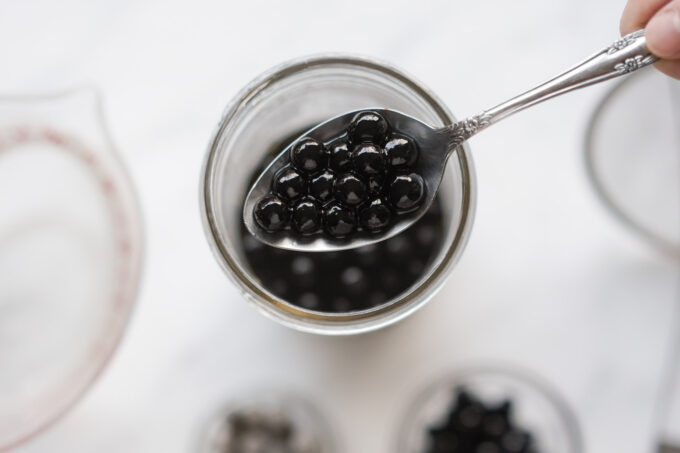
Step 5. (Optional) If the boba are cooked, you can now choose to sweeten your boba with a few tablespoons of dark brown sugar or honey for an additional 10 minutes.
Quick cooking method – WuFuYuan & E-FA brand pearls
This quick method is based on two very specific boba brands: WuFuYuan and E-Fa boba. These brands have boba that’s quick to make in about five minutes and you don’t even need to soak the boba first. If you don’t know if your boba is quick cooking or it doesn’t specifically state on the label it is quick cooking, I would recommend using the 30 & 30 method above.
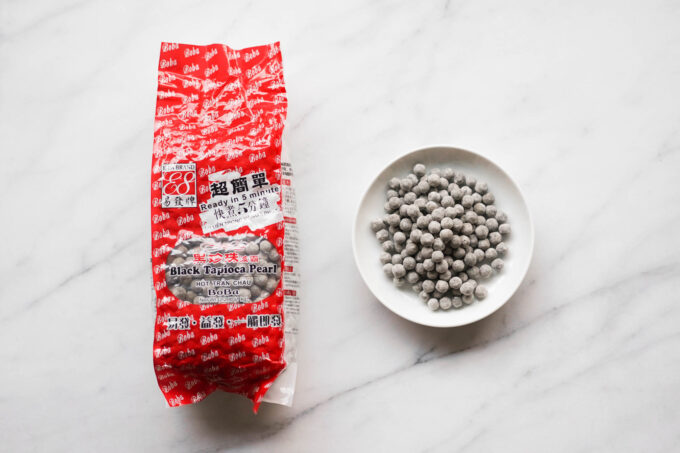
For different sizes and types of brown tapioca pearls, the steps and timing can vary so make sure you reference the package first. However, here’s how I’ve done it:
Step 1. Bring your water to a boil over high heat. Don’t add the boba yet.
Step 2. When the water is boiling, add your boba carefully (they may splatter a bit) and wait until the boba begins to float. I prefer WuFuYuan’s medium sized brown boba.
Step 3. After all the boba floats to the top, lower the heat to medium, cover the pot and cook for an additional two to three minutes. I watch over the pearls throughout this entire time because they cook fairly fast.
Step 4. Test one ball and test for chewiness to make sure it’s cooked and transfer the boba to a new container. The texture should be chewy, but slightly al dente. You want to remove the boba from the pot before it gets too soft and begins to degrade. The boba will also continue to cook slightly after removing them from the water, too, so keep that in mind.
Step 5. I don’t know about you, but I like to add extra flavor to my boba by soaking it further in a simple syrup sauce using the leftover water and brown sugar. Add this sauce into the boba container and soak for about 10 minutes. Soaking the boba also keeps your boba from sticking to one another and drying out before adding them in your drink or dessert.
Step 6. This should give you chewy and sweetened boba. Now you can add the sweetened boba to your drinks and dessert and enjoy!
Some frequently asked questions:
What are tapioca pearls?
While historically tapioca pearls have been made of other starches like rice flour, tapioca pearls are most popularly made out of hot water and tapioca starch and then rolled into balls.
Tapioca pearls originated from southeast Asia and are used in various types of desserts and drinks like milk tea and Thai tea.
Boba comes in different sizes and colors. You can find tapioca pearls at your local Asian grocery store, like 99 Ranch Market, or at various online retailers. Here are different varieties of boba:
- White tapioca pearls: This typically has a plain flavor because it’s made of just two ingredients: tapioca starch and water. The pearls look white and after they’re cooked turn slightly translucent with a chewy opaque center.
- Black tapioca pearls: This type of boba is similar to white tapioca pearls except they have added ingredients like brown sugar to give it a darker opaque color.
- Rainbow tapioca pearls: These are similar to white tapioca pearls, except they are colored. They will turn opaque in color and if you want extra flavor, you can also soak them in sweet syrup or honey after cooking.
How to store tapioca pearls
If you have any dry, unused tapioca pearls, I like to keep them in an airtight container and keep them in my refrigerator to keep them extra fresh. In my fridge, they last a couple months.
For cooked pearls, I would eat those up ASAP because the longer you keep them out, the gummier they become due to the tapioca starch.
How do you eat tapioca pearls?
Tapioca pearls are very versatile in Asian desserts. Most popularly you can add them in milk tea drinks like hot almond milk tea, taro milk tea, or Thai tea, but they can also be used in traditional desserts, like chè chuối.
Do you have to soak tapioca pearls?
Depending on the type of tapioca pearls you purchase, and what the packaging says, I like to soak the pearls in sugar syrup or honey after cooking to give them extra flavor and sweetness.
Can you use white tapioca pearls for bubble tea?
Yes, you can use white tapioca pearls (it has different cooking instructions), but I would soak them in sugar syrup or honey after cooking so they taste sweet. Otherwise, white tapioca pearls are fairly unflavored.
Why did my tapioca pearls dissolve?
The longer pearls are in liquid, the more they disintegrate. This is why you need to serve and consume pearls as soon as possible.
What are tapioca pearls made of?
Boba are chewy, round balls made of tapioca flour and water.
Why is it called boba?
Boba is a nickname for tapioca pearls added into milk tea. This nickname originated from its first introduction in Hong Kong, when people started to call the tapioca pearls “boba” because they resembled big pearls.
What’s the difference between boba and bubble tea?
Boba and bubble tea are different terms for the same thing. While boba can refer to the actual tapioca pearls, it can also refer to the milk tea drink and bubble tea is just a nickname of the milk tea, too.
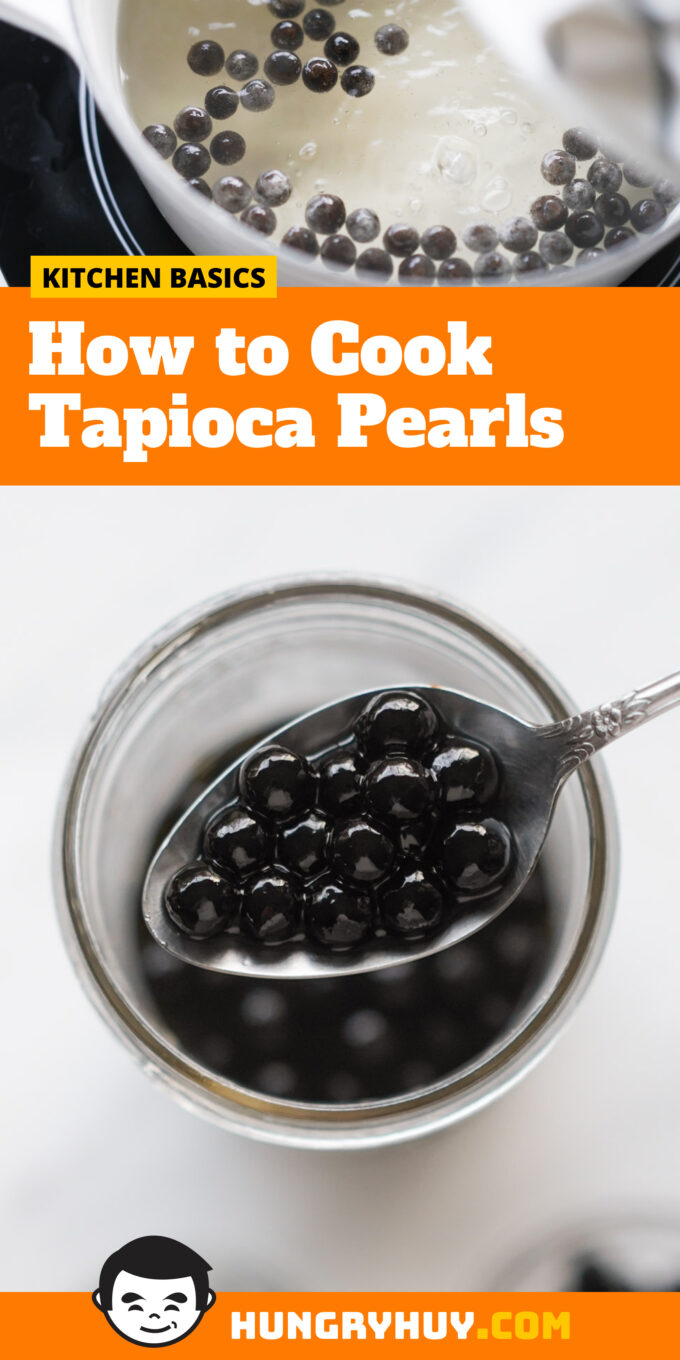
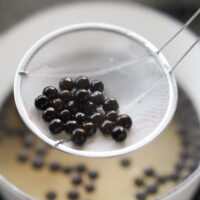
30 & 30 Cooking Method for Brown Boba
Ingredients
- 1/2 c tapioca pearls
- 10 c filtered water
- 2 tbsp sugar or honey
Instructions
- In a large pot, add 10 cups of water and bring to a boil.
- When it hits a rolling boil, add the tapioca pearls and wait for them to float to the top of the water. Once the boba is floating, lower to medium heat.
- Continue to simmer for 30 minutes uncovered. Stir occasionally to prevent the pearls from sticking.
- After 30 minutes, remove the pot from the stove, cover with lid, and let rest another 30 minutes.
- Strain the boba and rinse under cold running water to stop the cooking and remove the starchy outer layer.
- Taste-test the tapioca pearls and test if they're fully cooked through. They should be soft and chewy, but not crumble when you eat it. Note that just because the centers may look opaque it doesn't mean it's raw. They can still be cooked fully, so you need to taste test to make sure they’re cooked.
- If the pearls are still not cooked throughout or have hard centers, repeat steps 2-6 with a new batch of water.
- To sweeten your boba after they are finished cooking, add about two tablespoons of sugar or honey on top and let sit for an additional 10 minutes.
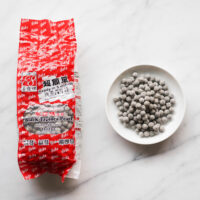
Quick cooking method – WuFuYuan & E-FA brand pearls
Ingredients
- 5 ½ c water
- ½ c tapioca pearls medium sized WuFuYuan brand preferred
- 1 c brown sugar
Instructions
- In a medium sized pot, boil water on high heat. (DO not add the boba until after the water is boiling.) This boba package calls for adding the boba slowly to boiling water as you stir to prevent sticking.
- Once the boba floats to the top, reduce heat to medium and cover the pot. Cook for two to three minutes.
- After two minutes, try a pearl to check for doneness. Keep cooking if needed until the texture just about reaches desired doneness–it will keep cooking a tiny bit more in the next steps.
- In a separate medium sized bowl, mix brown sugar and ½ cup of boiling water (taken from the pot of boba) together to make a sugar syrup.
- Drain the rest of the water and transfer boba pearls directly to the sugar syrup container. Cover for ten minutes. The end result should be chewy and sweet boba. Keep the boba in the simple syrup until assembly. You will also be using the simple syrup from this to sweeten your tea.
Notes
- This recipe is specifically for medium sized brown tapioca pearls. Different types of boba require different instructions, make sure to read your boba packaging before cooking.
- Don’t try to wash or rinse the boba before cooking them.
- Make sure to only put the boba in the water AFTER it has already boiled.



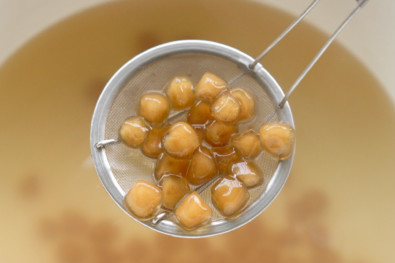
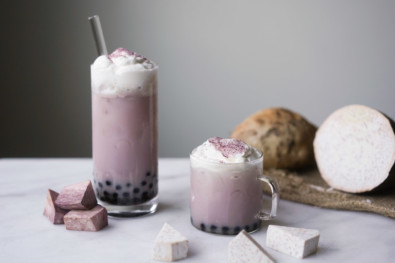





Thanks a lot! The quick cooking method worked just right with the tapioca pearls my parents bought, unfortunately the instructions were not translated and I found your website and decided to try. Thanks for sharing!
Katagirl, thanks for sharing! Isn’t that odd? The only reason I see for packages omitting instructions is there are too many variables they don’t want to be held responsible for.
Thanks so much for posting this recipe! I bought my husband a Boba tea kit for Christmas; the kit contained uncooked black tapioca pearls and no instructions on how to prepare them, so we used them raw and it was a gross disaster (the uncooked pearls fused into a chalky, undissolved mass at the bottom of the glass). The manufacturer didn’t respond to my question about how to fix the pearls, so I Googled Boba pearls and found your page – your 30/30 method is perfect and resulted in tasty pearls in the tea. Thank you again!
Ah why do they even sell this witihout instructions.. insanity. Glad this worked for you MMR!
stunning, exhaustive coverage of boba.
you even covered the 5 minute brands.
if it wasn’t for you i would have done the
15/15 or 30/30 method…and ruined it.
great website. it’s nice to see EXCELLENCE.
no response requested,
roger
Thanks for this post! I wanted to try a recipe with boba and didn’t know what brand to use as I have never made it at home. I just tried WuFuYuan brand and they were so fast and tasty 🙂